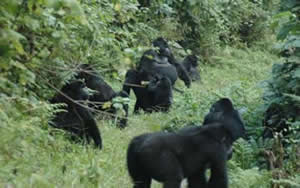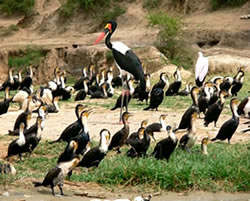Tourist Attractions in Uganda
The distinctive attraction of Uganda as a tourist destination arises out of the variety of its game stock and its unspoilt scenic beauty. Ugandagenerally has substantial natural resources for tourism with a variety of landscape and ecosystems, climates and cultures. Some of its features are outstanding by international standards such as the sheer variety of bird species, while others are unique. The Ugandan experience has novelty and rarity values not easily found elsewhere in Africa.
\r\nThe Uganda Tourist Board, with the assistance of the European Union, has identified several tourist products that it is felt can attract visitors to Uganda in their own right. These include:
\r\n- \r\n
- \r\n Avi-tourism (bird watching)\r\n \r\n
- \r\n Sport fishing\r\n \r\n
- \r\n Boating\r\n \r\n
- \r\n Primate tracking (Gorillas, Chimps and others)\r\n \r\n
- \r\n Game Viewing\r\n \r\n
- \r\n Walking and trekking\r\n \r\n
- \r\n Mountaineering\r\n \r\n
- \r\n White water rafting\r\n \r\n
- \r\n National Parks\r\n \r\n
Most of Uganda's wildlife is concentrated in its protected areas, of which there are three main categories: National Parks, Wildlife Reserves, and Forest Reserves. The conservation and management of these areas falls under two principal agencies, the Uganda Wildlife Authority under the Ministry of Tourism, Trade and Industry and the National Forest Authorityunder the Ministry of Natural Resources. Uganda has established 10 National Parks, enabling tourists to enjoy the pristine wilderness environment.
\r\nMurchison Falls National Park
\r\n \r\n
\r\nThis is the largest National Park in Uganda covering 3,877 sq km and one of the most spectacular in Africa. At the Murchison Falls, the river Nile plunges through a narrow crevice and over a 40-metre drop. In the eastern sector of the park, before the Murchison Falls themselves, are the Karuma Falls, where the Nile cascades over a breathtaking 23 km of rapids, creating some of the most exciting white-water rafting opportunities in Africa. A cruise upstream the Nile to the Falls is an unforgettable experience. On the banks, prolific wildlife including elephant, crocodile, hippopotamus, lion, giraffe, buffalo, and countless antelopes and birds can be observed.
\r\nQueen Elizabeth National Park
\r\nThe Queen Elizabeth National Park has been designated a Biosphere Reserve for Humanity under UNESCO auspices. The park, in the western arm of the Great East African Rift Valley, covers 2,056 sq. km and includes a remarkable variety of ecosystems, from semi-deciduous tropical forest to green meadows, savannah and swamps. It is the home of the famous tree-climbing lion as well as the Uganda Kob, other antelope species, elephant, baboons, hippos, buffalo and chimpanzees. Over 500 species of birds have been recorded, making the park a magnet for bird watchers. The bird species include the black bee-eater, 11 types of king fisher, Shoebill storks and several species of falcons, eagles and other raptors. In the crater lakes to the north, flocks of flamingos can be found. A favourite way to view the game is by launch trip on the Kazinga Channel between Lakes George and Edward.
\r\nBwindi Impenetrable Forest
\r\n \r\n
\r\nThe park with its dense ground cover of vines and shrubs is home to the world famous mountain gorillas, of which they are less than 600 still left in the entire world. Gorilla permits are required for tracking the gorillas and it is, therefore, advisable to make reservations at least three months in advance. Bwindi is one of the richest areas for flora in Eastern Africa. The forest is also sanctuary for Columbus monkeys, chimpanzees and many bird types including some endangered species.
Mgahinga Gorilla
\r\nThis is yet another haven for the persecuted mountain gorilla. Located on the slopes of the Virunga Mountains, in the extreme southwest corner of Uganda, the park has been set aside to provide a secure habitat for the gorillas. However, besides the gorillas, other wildlife may also be viewed including the leopard, giant forest hog, bushbuck, buffalo, and golden monkey. The summit of Mount Muhavura (4,127 m) has a small crater lake.
\r\nKibale Forest National Park
\r\nThe rainforest is situated to the north-east of Queen Elizabeth National Park. In addition to forest, there are also areas of grassland and swamp. The park is noted for its primate population 13 different species inhabit the park including many families of chimpanzees and several types of Columbus monkeys. Bushbuck, waterbuck, duiker and giant forest hog may also be seen. The forests and the grasslands support abundant bird life almost 300 species have been identified and 144 types of butterfly.
\r\nKidepo National Park
\r\nThe Park is located in North East Uganda and covers 1,436 sq. km. It is inhabited by various wildlife including elephant, buffalo, lion, leopard, cheetah, giraffe, various antelope species, baboon, bushbaby and over 200 species of bird. Two game viewing routes connect the rest camp with the prime wildlife areas near the Winwing River and the rock escarpment to the southwest. On the park's northern borders are the Kananorok Hot Springs.
\r\nMount Elgon
\r\n \r\n
\r\nThis is an extinct volcano located on Uganda's eastern border. The mountain boasts numerous interesting features including gorges, ancient caves, water falls and hot springs. Birdlife is abundant on the mountain although various wildlife may also be encountered.
\r\n
Semuliki National Park
\r\nThis is the only park in Uganda to be composed primarily of tropical lowland forest. The forest is very dense and quite flat, creating a startling contrast to the rugged Rwenzori Mountains nearby. The Semliki River attracts many animals. The park is home to eight species of primate, 400 birds and 300 butterfly species. Elephant, buffalo, leopard, civet, bushbaby and flying squirrels are also found.
\r\nLake Mburo National Park
\r\nSituated between the towns of Masaka and Mbarara, this comparatively small park (371 sq. km) is composed primarily of grassland, wetland and acacia woodland. At the centre lies the Lake Mburo, which together with 14 other lakes, forms part of an extensive wetland area. Animals to be found in the park include the impala, eland, rock hyrax, zebra, waterbuck, buffalo, warthog, leopard, civet, hyena, hippo, and crocodile. There are also over 357 species of birds including the marabou stock and the crowned crane.
\r\nRwenzori Mountains
\r\nThe mist-shrouded peaks of the Mountains of the Moon provide a stunning backdrop to this magnificent park, located on Uganda's western border. In the centre of the range, some of the peaks are permanently covered in snow and glaciers, while the lower slopes are covered with dense forests. Here is the third highest mountain in Africa, Mt. Magherita, which rises to 5,100 metres above sea level. Walking tours in the foothills are a feature, although only the experienced and fit should attempt an ascent on the peaks, which rival the Alps in difficulty. Some of the wildlife to be found in the mountains include the chimpanzees, along with the blue monkey, hyrax, giant forest hog and many unique bird species such as the Rwenzori touraco, the francolin and the olive pigeon.
\r\nThe Uganda Wildlife Education Centre (UWEC)
\r\nThe Uganda Wildlife Education Centre in Entebbe was created by the Government of Uganda with the help of the Wildlife Conservation Centre in New York. The Centre has grown considerably in recent years and hosts a variety of wildlife. UWEC is not a zoo as the centre environment has been designed to be as close as possible to the wild. At the centre, visitors are able to observe many of the indigenous species to be found in Uganda and also to receive comprehensive information on the species, their natural habitats and the complex ecologies of Uganda.
\r\nPeople and Culture
\r\n \r\n
\r\nUgandan society is still predominantly rural with 80% of the population living in rural areas. Traditional customs and lifestyles are still alive in many parts of the country, which adds spice to the tourist experience. Ugandans generally have a reputation for openness, and a friendly attitude to visitors. There are various peoples that make up Uganda and each group have their own traditional customs and ways of life.
\r\nThese customs are kept alive by many colourful ceremonies marking specific historical events or celebrating the seasons of the year. Spontaneous dancing and music are typical of life in Uganda and visitors are often welcome to observe these ceremonies although as a courtesy, tourists should always seek permission before taking photographs. In addition to the rich cultural experiences, tourists can choose souvenirs from countless local traditional art pieces and handcrafts. These are sold in most villages, along the roadsides, and also at specific tourist curio shops within the capital.
\r\n
Besides, there are also a number of cultural sites, which tourists will be able to visit. These include the Kasubi Royal Tombs and a host of other historical sites in many different parts of the country.
\r\nLakes and Rivers
\r\n \r\n
\r\nUganda has been called a land of lakes because almost a third of the country is covered by water. Lake Victoria, the largest in Africa, dominates the southern border of the country while Lakes Edward and Albert lie to the west. Linked to Lake Edward is the Kazinga Channel, Lake Mburo, 230 km to the west of Kampala, is the only lake entirely within a National Park. In the centre of Uganda, Lakes Kwania and Kyoga are fed by the waters of the River Nile.
\r\nOther lakes include Lake Bunyonyi near Kabale and Lake Bisina in the shadow of Mt. Elgon, as well as tiny crater lakes high in the mountains.Uganda's fresh water lakes offer opportunities for water activities and sports. An example is white water rafting, pioneered by Adrift, which has caught on as a popular tourist activity, especially on the River Nile. The country now attracts 500 rafters every month. Lake Victoria is now also being increasingly used for lake cruises. Other popular activities include sport fishing and sailing.
\r\nFlora and Fauna
\r\nUganda is a country of exceptional diversity. It lies at the overlap between tropical East African savannah and the West African rainforest zones. Seven of Africa's 18 plant kingdoms are represented in Uganda, which is more than any other country on the continent. The tropical rain forests of Western Uganda have unique flora and fauna, some of which are endangered species. As part of the emphasis on eco-tourism and in response to increasing demand from tourists, new nature trails have been developed in virtually every protected area. These trails offer an unhurried way of exploring the wilderness and getting near to nature.
\r\nBird Life
\r\n\r\n The birding opportunities in Uganda are impressive. With over 1,000 recorded already, Uganda has almost half the species known on the African continent and over 10% of those on record throughout the entire world. Uganda's equatorial location, combined with the altitude and great variety of terrain types provide an overwhelming array of opportunities for keen birders. The Queen Elizabeth National Park alone has 550 avian species.
The birding opportunities in Uganda are impressive. With over 1,000 recorded already, Uganda has almost half the species known on the African continent and over 10% of those on record throughout the entire world. Uganda's equatorial location, combined with the altitude and great variety of terrain types provide an overwhelming array of opportunities for keen birders. The Queen Elizabeth National Park alone has 550 avian species.
\r\n
The Ssese Islands
\r\nConsisting of 84 islands in the north-western section of Lake Victoria, the Ssese Islands have, for a long time, only been visited by local people and campers because of lack of tourist facilities. Now three campsites have been opened which can be booked through local tour operators. Nevertheless, many of the islands are uninhabited except for a few fishermen so their forests and swamps are ideal habitats for birds. The wildlife on the islands includes hippos, crocodile, waterbuck, sitatunga antelope, chimpanzees and monkeys. The islands can be reached by a nine-hour steamer trip fromPort Bell or a 45-minute ferry trip from Bukakata.
\r\n



